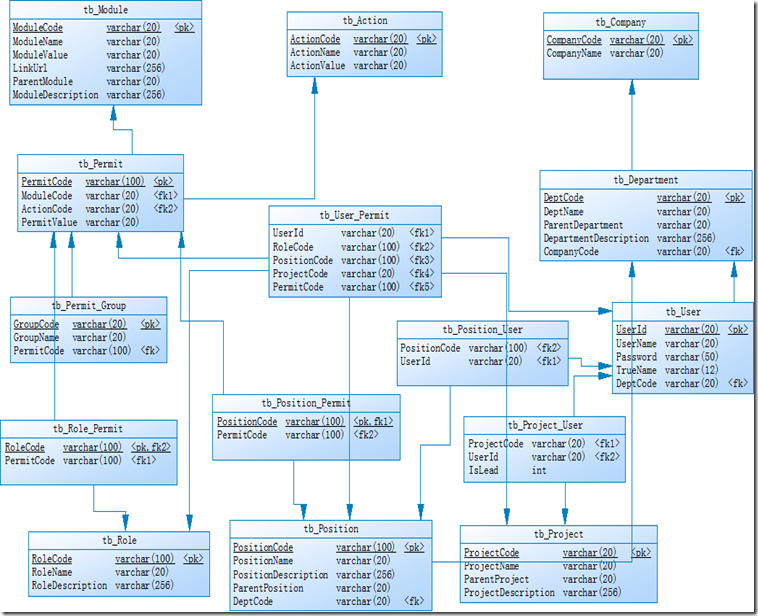OA系统权限管理设计方案学习
学习之:http://www.cnblogs.com/kivenhou/archive/2009/10/19/1586106.html
此为模型图:

据此写了sql语句:
drop table if exists tb_Permit_Group;
drop table if exists tb_Position_Permit;
drop table if exists tb_Position_User;
drop table if exists tb_Project_User;
drop table if exists tb_Role_Permit;
drop table if exists tb_User_Permit;
drop table if exists tb_User;
drop table if exists tb_Permit;
drop table if exists tb_Action;
drop table if exists tb_Position;
drop table if exists tb_Department;
drop table if exists tb_Company;
drop table if exists tb_Module;
drop table if exists tb_Project;
drop table if exists tb_Role;
/*==============================================================*/
/* Table: tb_Action */
/*==============================================================*/
create table tb_Action
(
ActionCode varchar(20) not null,
ActionName varchar(20),
ActionValue varchar(20),
primary key (ActionCode)
);
/*==============================================================*/
/* Table: tb_Company */
/*==============================================================*/
create table tb_Company
(
CompanyCode varchar(20) not null,
CompanyName varchar(20),
primary key (CompanyCode)
);
/*==============================================================*/
/* Table: tb_Department */
/*==============================================================*/
create table tb_Department
(
DeptCode varchar(20) not null,
DeptName varchar(20),
ParentDepartment varchar(20),
DepartmentDescription varchar(256),
CompanyCode varchar(20),
primary key (DeptCode)
);
/*==============================================================*/
/* Table: tb_Module */
/*==============================================================*/
create table tb_Module
(
ModuleCode varchar(20) not null,
ModuleName varchar(20),
ModuleValue varchar(20),
LinkUrl varchar(256),
ParentModule varchar(20),
ModuleDescription varchar(256),
primary key (ModuleCode)
);
/*==============================================================*/
/* Table: tb_Permit */
/*==============================================================*/
create table tb_Permit
(
PermitCode varchar(100) not null,
ModuleCode varchar(20),
ActionCode varchar(20),
PermitValue varchar(20),
primary key (PermitCode)
);
/*==============================================================*/
/* Table: tb_Permit_Group */
/*==============================================================*/
create table tb_Permit_Group
(
GroupCode varchar(20) not null,
GroupName varchar(20),
PermitCode varchar(100),
primary key (GroupCode)
);
/*==============================================================*/
/* Table: tb_Position */
/*==============================================================*/
create table tb_Position
(
PositionCode varchar(100) not null,
PositionName varchar(20),
PositionDescription varchar(256),
ParentPosition varchar(20),
DeptCode varchar(20),
primary key (PositionCode)
);
/*==============================================================*/
/* Table: tb_Position_Permit */
/*==============================================================*/
create table tb_Position_Permit
(
PositionCode varchar(100) not null,
PermitCode varchar(100),
primary key (PositionCode)
);
/*==============================================================*/
/* Table: tb_Position_User */
/*==============================================================*/
create table tb_Position_User
(
PositionCode varchar(100),
UserId varchar(20)
);
/*==============================================================*/
/* Table: tb_Project */
/*==============================================================*/
create table tb_Project
(
ProjectCode varchar(20) not null,
ProjectName varchar(20),
ParentProject varchar(20),
ProjectDescription varchar(256),
primary key (ProjectCode)
);
/*==============================================================*/
/* Table: tb_Project_User */
/*==============================================================*/
create table tb_Project_User
(
ProjectCode varchar(20),
UserId varchar(20),
IsLead int
);
/*==============================================================*/
/* Table: tb_Role */
/*==============================================================*/
create table tb_Role
(
RoleCode varchar(100) not null,
RoleName varchar(20),
RoleDescription varchar(256),
primary key (RoleCode)
);
/*==============================================================*/
/* Table: tb_Role_Permit */
/*==============================================================*/
create table tb_Role_Permit
(
RoleCode varchar(100) not null,
PermitCode varchar(100),
primary key (RoleCode)
);
/*==============================================================*/
/* Table: tb_User */
/*==============================================================*/
create table tb_User
(
UserId varchar(20) not null,
UserName varchar(20),
Password varchar(50),
TrueName varchar(12),
DeptCode varchar(20),
primary key (UserId)
);
/*==============================================================*/
/* Table: tb_User_Permit */
/*==============================================================*/
create table tb_User_Permit
(
UserId varchar(20),
RoleCode varchar(100),
PositionCode varchar(100),
ProjectCode varchar(20),
PermitCode varchar(100)
);
alter table tb_Department add constraint FK_Reference_5 foreign key (CompanyCode)
references tb_Company (CompanyCode) on delete restrict on update restrict;
alter table tb_Permit add constraint FK_Reference_3 foreign key (ModuleCode)
references tb_Module (ModuleCode) on delete restrict on update restrict;
alter table tb_Permit add constraint FK_Reference_4 foreign key (ActionCode)
references tb_Action (ActionCode) on delete restrict on update restrict;
alter table tb_Permit_Group add constraint FK_Reference_18 foreign key (PermitCode)
references tb_Permit (PermitCode) on delete restrict on update restrict;
alter table tb_Position add constraint FK_Reference_21 foreign key (DeptCode)
references tb_Department (DeptCode) on delete restrict on update restrict;
alter table tb_Position_Permit add constraint FK_Reference_19 foreign key (PermitCode)
references tb_Permit (PermitCode) on delete restrict on update restrict;
alter table tb_Position_Permit add constraint FK_Reference_9 foreign key (PositionCode)
references tb_Position (PositionCode) on delete restrict on update restrict;
alter table tb_Position_User add constraint FK_Reference_11 foreign key (PositionCode)
references tb_Position (PositionCode) on delete restrict on update restrict;
alter table tb_Position_User add constraint FK_Reference_6 foreign key (UserId)
references tb_User (UserId) on delete restrict on update restrict;
alter table tb_Project_User add constraint FK_Reference_22 foreign key (ProjectCode)
references tb_Project (ProjectCode) on delete restrict on update restrict;
alter table tb_Project_User add constraint FK_Reference_23 foreign key (UserId)
references tb_User (UserId) on delete restrict on update restrict;
alter table tb_Role_Permit add constraint FK_Reference_1 foreign key (RoleCode)
references tb_Role (RoleCode) on delete restrict on update restrict;
alter table tb_Role_Permit add constraint FK_Reference_17 foreign key (PermitCode)
references tb_Permit (PermitCode) on delete restrict on update restrict;
alter table tb_User add constraint FK_Reference_20 foreign key (DeptCode)
references tb_Department (DeptCode) on delete restrict on update restrict;
alter table tb_User_Permit add constraint FK_Reference_12 foreign key (UserId)
references tb_User (UserId) on delete restrict on update restrict;
alter table tb_User_Permit add constraint FK_Reference_13 foreign key (RoleCode)
references tb_Role (RoleCode) on delete restrict on update restrict;
alter table tb_User_Permit add constraint FK_Reference_14 foreign key (PositionCode)
references tb_Position (PositionCode) on delete restrict on update restrict;
alter table tb_User_Permit add constraint FK_Reference_15 foreign key (ProjectCode)
references tb_Project (ProjectCode) on delete restrict on update restrict;
alter table tb_User_Permit add constraint FK_Reference_16 foreign key (PermitCode)
references tb_Permit (PermitCode) on delete restrict on update restrict;
OA系统权限管理设计方案学习的更多相关文章
- OA系统权限管理设计方案
(转)OA系统权限管理设计方案 OA系统权限管理设计方案 不同职责的人员,对于系统操作的权限应该是不同的.优秀的业务系统,这是最基本的功能. 可以对“组”进行权限分配.对于一个大企业的 ...
- OA系统权限管理设计方案【转】
l 不同职责的人员,对于系统操作的权限应该是不同的.优秀的业务系统,这是最基本的功能. l 可以对“组”进行权限分配.对于一个大企业的业务系统来说,如果要求管理员为其下员工逐一分配系统操作权限的话,是 ...
- OA系统权限管理设计(转载)
不论什么系统都离不开权限的管理,有一个好的权限管理模块,不仅使我们的系统操作自如,管理方便,也为系统加入亮点. l 不同职责的人员,对于系统操作的权限应该是不同的.优秀的业务系统,这是 ...
- OA系统 权限管理的设计流程
版权声明:本文为博主原创文章,遵循CC 4.0 BY-SA版权协议,转载请附上原文出处链接和本声明. 本文链接:https://blog.csdn.net/u013630349/article/det ...
- Android权限管理知识学习记录
一.Android权限背景知识 在Android 6.0之前,所申请的权限只需要在AndroidManifest.xml列举就可以了,从而容易导致一些安全隐患,因此,在Android 6.0时,Goo ...
- OA(权限管理初步模块)
权限管理:一般指根据系统设置的安全规则或者安全策略,用户可以访问而且只能访问自己被授权的资源,不多不少.权限管理几乎出现在任何系统里面,只要有用户和密码的系统. 根据权限管理的套路,我们一般从这三个角 ...
- 潭州课堂25班:Ph201805201 django框架 第十三课 自定义404页面,auth系统中的User模型,auth系统权限管理 (课堂笔记)
当 DEBUG=True 时,django 内部的404报错信息, 自带的报错信息, 要自定义404信息,要先把 DEBUG=False , 之后要自定义4040页面,有两种方法, 方法1,在创建40 ...
- 使用shiro做权限管理的学习笔记整理
Shiro权限管理 参考:https://www.cnblogs.com/jpfss/p/8352031.html Shiro解决的问题 授权和鉴别的问题:Authenrization(授权) Aut ...
- 2018/09/05《涂抹MySQL》【权限管理】学习笔记(二)
读 第四章<管理MySQL库与表> 第五章<MySQL的权限管理> 总结 1:当配置好 MySQL 数据库后,发现有几个默认的库,他们的意义和作用?(这里只做简单了解,之后用到 ...
随机推荐
- POI做题记录:第二届POI
Trees Memory limit: 32 MB Trees occur very often in computer science. As opposed to trees in nature, ...
- 【转】如何使用Unity创造动态的2D水体效果
原文:http://gamerboom.com/archives/83080 作者:Alex Rose 在本篇教程中,我们将使用简单的物理机制模拟一个动态的2D水体.我们将使用一个线性渲染器.网格渲染 ...
- 6N137的使用
(1)引脚图 (2)功能表 (3)内部结构图 信号从2.3脚输入,反向偏置的光敏二极管受光照后导通,经过电流电压转换,输入到与门一端,与门另一端为使能端.由于输入信号为集电极开路,需要加上拉电阻.当使 ...
- HDOJ 2012 素数判定
Problem Description 对于表达式n^2+n+41,当n在(x,y)范围内取整数值时(包括x,y)(-39<=x < y<=50),判定该表达式的值是否都为素数. I ...
- FBReader移植日记 第二天
昨天我们的移植工作进行了一大半,还留下两个重要的部分没有完成:1.没有移植的 ZLTextView,2.FormatPlugin相关的类. 第一个问题我们放在后面解决,下面先解决格式插件的问题. 我们 ...
- spring框架DI(IOC)和AOP 原理及方案
http://www.blogjava.net/killme2008/archive/2007/04/20/112160.html http://www.oschina.net/code/snippe ...
- 两种常用的启动和关闭MySQL服务
本博文的主要内容有 .通过图形界面来启动和关闭MySQL服务 .通过DOS窗口来启动和关闭MySQL服务 1.通过图形界面来启动和关闭MySQL服务 2.通过DOS窗口来启动和关闭MySQL服务 感谢 ...
- Google图片搜索
本博文的主要内容有 .Google图片搜索的介绍 .Google图片之普通搜索 .Google图片之高级搜索 1.Google图片搜索的介绍 Google的图片搜索,不仅通过关键字查找拥有特 ...
- 西安Uber优步司机奖励政策(1月25日~1月31日)
滴快车单单2.5倍,注册地址:http://www.udache.com/ 如何注册Uber司机(全国版最新最详细注册流程)/月入2万/不用抢单:http://www.cnblogs.com/mfry ...
- N2N 对等VPN网络
n2n是一个二层的虚拟专网,允许用户开发网络中典型的P2P应用而不是在应用层开发.这就意味着用户可以透明的得到本地地址,只要新的IP地址在一个子网内,无论两台机器处于什么位置都能够ping通对方. N ...
